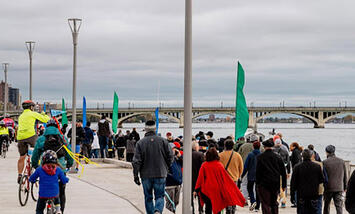
One of the positive things that many cities worldwide have done over the last half century is to transition the relics of their industrial era – the port facilities, the warehouses, railyards and more that defined manufacturing – to uses that would appeal to a new creative class demographic. These spaces have become new entertainment sites, offices, retail, residential and recreational uses, depending on the site. The new uses have brought an added element to the quality of life cities can offer.
However, not all cities have been able to make the transition. American Rust Belt cities, for example, have lagged behind other cities in making the switch. For far too long, these cities have been defined by the decaying factories and vacant land. The Rust Belt failure to transition continues to tarnish their image, and constrains their ability to be competitive with other cities nationwide.
But a new addition to Detroit’s landscape can help change its image. In October, the Detroit Riverfront Conservancy celebrated the opening of a new stretch of the Detroit Riverwalk, the Uniroyal Promenade. It’s the newest segment of the unbroken 4-mile-long riverfront path and trail along the Detroit River.
The Conservancy is a non-profit organization founded in 2003 that took on the task of bringing a new public and recreational vision for a 5 ½ mile stretch of the city’s riverfront – from the Ambassador Bridge connecting Detroit to Canada on the west, and to Gabriel Richard Park and Detroit’s jewel park, Belle Isle in the Detroit River, to the east. Ever since, the Conservancy has been the leader in transforming the Motor City’s waterfront.
I’ve often referred to a quote from a 1961 Time Magazine article entitled Decline in Detroit:
"If ever a city stood as a symbol of the dynamic U.S. economy, it was Detroit. It was not pretty. It was, in fact, a combination of the grey and the garish: its downtown area was a warren of dingy, twisting streets; the used-car lots along Livernois Avenue raised an aurora of neon. But Detroit cared less about how it looked than about what it did—and it did plenty.”
It must be noted that Detroit wasn’t always that careless about its appearance. Prior to the city’s establishment as the world’s automobile capital, Detroit had often been referred to as the "Paris of the Midwest" – a reference to its French heritage, and the broad diagonal avenues and boulevards that were imagined in the well-before-its-time Woodward Plan. Prior to 1910 or so, before automobile manufacturing shifted into high gear, Detroit cared quite a bit about its appearance. However, Detroit left its beautiful side behind as it became an industrial power.
Of course, Detroit was not alone in this. Lakes and rivers were the first interstate highways, and they were used for commerce. The waterfronts of Great Lakes cities like Buffalo, Cleveland and Gary were dotted with smokestacks and silos. River cities like Minneapolis, St. Louis and Cincinnati also contained factories that assembled goods and docks to distribute them. Like many cities built on industry, Detroit had a long history of manufacturing uses on its primary waterway. As manufacturing receded as a key part of the American economy, they fell into disrepair and became a blighting influence on the city.
Read the rest of this piece at Corner Side Yard Blog.
Pete Saunders is a writer and researcher whose work focuses on urbanism and public policy. Pete has been the editor/publisher of the Corner Side Yard, an urbanist blog, since 2012. Pete is also an urban affairs contributor to Forbes Magazine's online platform. Pete's writings have been published widely in traditional and internet media outlets, including the feature article in the December 2018 issue of Planning Magazine. Pete has more than twenty years' experience in planning, economic development, and community development, with stops in the public, private and non-profit sectors. He lives in Chicago.
Photo: Visitors check out the latest addition to the Detroit Riverwalk, the Uniroyal Promenade, at its grand opening on October 21, 2023. Source: detroit.urbanize.city












